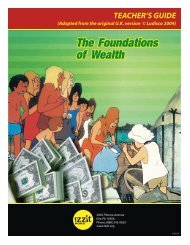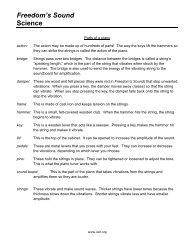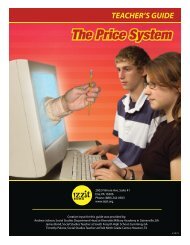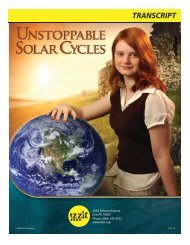Transcript - Izzit.org
Transcript - Izzit.org
Transcript - Izzit.org
Create successful ePaper yourself
Turn your PDF publications into a flip-book with our unique Google optimized e-Paper software.
TRADER: Oh, champion.<br />
WOMAN: There you are. And this is how we did it.<br />
MAN: We divided the work into separate processes, so that each one of the ten of us specialized in just<br />
one thing. The result was: we doubled our productivity; we produced twenty shawls in two weeks.<br />
WOMAN: Before, using the old ways, we would have produced only ten. We’d created the extra ones<br />
by division of labor by process.<br />
MAN: But this time we used the surplus in a different way. We swapped it for somebody else’s surplus.<br />
WOMAN: And the result is: we’ve now got a lot of things we couldn’t have made for ourselves.<br />
MAN: What we discovered was: the division of labor by process has created more surplus…<br />
WOMAN: …and by trading that surplus, we’ve taken another step along the path to prosperity. Oh, the<br />
cooking I can do with this!<br />
MAN: Oh, just look at that!<br />
There are still quite a few places in the world today where division of labor by process is still at much the<br />
same point as in our village community. Some people spin, some people weave, some people finish off<br />
the goods. In the modern industrial world, it all looks very different, and so it is in a way, but if you<br />
follow manufacturing through, you’ll see that it’s still divided by process in just the same way- even if it<br />
is on a massive scale.<br />
WOMAN: The shearing and cleaning of wool is carried out on huge commercial sheep farms. The raw<br />
wool is spun into thread on enormous machines, with two hundred spindles that turn out twenty-three<br />
miles of yarn a minute.<br />
MAN: The yarn is woven on gigantic electrically-powered looms that produce almost an acre of cloth a<br />
day. It’s dyed in special machines, and then made into goods like these, which are sent off to the docks<br />
for export.<br />
WOMAN: And in return…we get other people’s surplus – beautiful fruit, tea and coffee – things we<br />
cannot produce ourselves. We don’t swap it directly the way our villagers did. We sell our products and<br />
use the money to buy the tea, but it comes to the same thing.<br />
MAN: And it’s made possible only because we’ve created a trading surplus, and created it through<br />
division of labor by process, one of the foundation stones of the modern industrial world.<br />
15

















